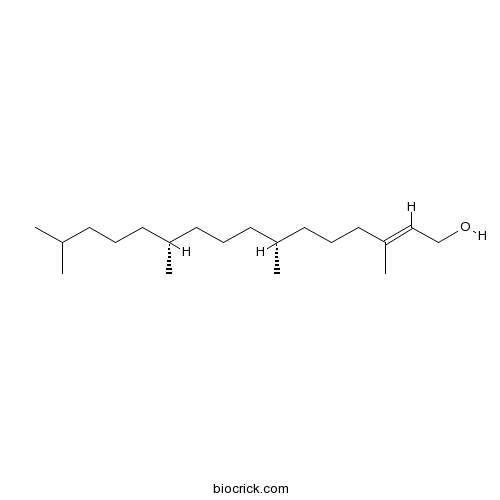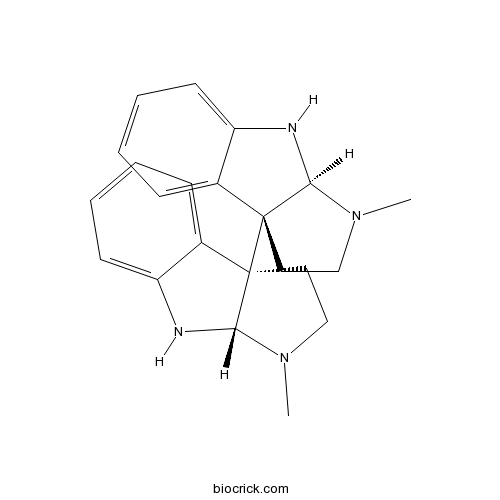Chimonanthus nitens
Chimonanthus nitens
1. The products in our compound library are selected from thousands of unique natural products; 2. It has the characteristics of diverse structure, diverse sources and wide coverage of activities; 3. Provide information on the activity of products from major journals, patents and research reports around the world, providing theoretical direction and research basis for further research and screening; 4. Free combination according to the type, source, target and disease of natural product; 5. The compound powder is placed in a covered tube and then discharged into a 10 x 10 cryostat; 6. Transport in ice pack or dry ice pack. Please store it at -20 °C as soon as possible after receiving the product, and use it as soon as possible after opening.
Natural products/compounds from Chimonanthus nitens
- Cat.No. Product Name CAS Number COA
-
BCN1673
Phytol150-86-7
Instructions

-
BCN7824
Chimonanthine5545-89-1
Instructions

Structural characterization and discrimination of Chimonanthus nitens Oliv. leaf from different geographical origins based on multiple chromatographic analysis combined with chemometric methods.[Pubmed: 29558724]
The Chimonanthus nitens Oliv. leaf (CNOL). is a widely used traditional Chinese medicine (TCM) used for treating colds and influenza. In the present study, a comprehensive strategy integrating multiple chromatographic analysis and chemometric methods was firstly proposed for structural characterization and discrimination of CNOL from different geographical origins. It consists of three steps: Firstly, the ultra-high-performance liquid chromatography quadrupole time-of-flight tandem mass spectrometry (UHPLC-QTOF-MS/MS) method was applied for comprehensive profiling of characterization constituents in CNOL by high-resolution diagnostic product ions/neutral loss filtering, and a total of 40 constituents were identified. Secondly, chemical fingerprints were established by HPLC coupled with photodiode array detector (PDA), and similarity analyses were calculated based on nineteen common characteristic peaks. Subsequently, the nine major constituents, including coumarins, flavonoids, and phenolic acids were quantified, and the quantitative data further analyzed by principal component analysis (PCA) and orthogonal partial least-squares discriminant analysis (OPLS-DA). Thirdly, a hot map visualization was conducted for clarifying the distribution of major compounds among different geographical origins. Also, nine constituents detected could be used as chemical markers for discrimination of CNOL from different provinces. Collectively, these results indicated that our proposed platform was a powerful tool for chemical profiling and discrimination of herbs with multiple botanical origins, providing promising perspectives in tracking the formulation process of TCMs products.
Anti-inflammatory properties of extracts from Chimonanthus nitens Oliv. leaf.[Pubmed: 28700722]
Chimonanthus nitens Oliv. (CN) is a species in the family Calycanthaceae. Its leaf is widely used to make traditional herbal tea in southern China and has a wide range of therapeutic effects. The profile of the ethanol extracts from CN leaves was identified by UPLC-QTOF-MS/MS. Forty seven compounds were determined including organic acids, phenolic acids and derivatives, flavonoids, coumarins, fatty acids and other compounds. The effect of the CN extracts on the inflammatory damage in zebrafish and in RAW 264.7 cells was investigated. The extracts demonstrated a strong ability to inhibit the recruitment of neutrophils in LPS-stimulated zebrafish, but macrophage migration was not significantly affected. Pro-inflammatory cytokines (i.e., TNF-α, IL-6 and IL-1β) were also determined by q-PCR. The extracts strongly reduced mRNA expression of TNF-α, IL-6 but not IL-1β in zebrafish model, while significantly inhibited the production of the factors in the RAW 264.7 cells. Therefore, our results suggest that the ethanol extracts of CN leaves may serve as a source of nutraceutical compounds with anti-inflammatory properties.
Constituent analysis of the ethanol extracts of Chimonanthus nitens Oliv. leaves and their inhibitory effect on α-glucosidase activity.[Pubmed: 28223131]
None
Study on quality standards for Chimonanthus nitens.[Pubmed: 27706658]
Chimonanthus nitens Oliv. is a commonly used traditional Chinese medicine. Terpenoids, flavonoids, and coumarins are usually considered its main bioactive ingredients. Thus, qualitative and quantitative analyses of these compounds are crucial in quality control studies of Chimonanthus nitens. In this study, five compounds were identified by double-development thin layer chromatography (TLC) and the content of four compounds was determined by high performance liquid chromatography; the detection wavelength was set to 344 nm and the column temperature was 40°C. All calibration curves showed good linear regression (R2 > 0.9995). The average recoveries ranged from 97.06 to 104.44%. The RSD was below 4.2%. Four compounds remained stable over 24 h and the relative standard deviation (RSD) of the precision of their measurement was less than 1.5%. The developed method was reproducible, sensitive, and simple, and could be used for quality control of Chimonanthus nitens.
[Study on quality standard of Chimonanthus nitens leaf].[Pubmed: 24620687]
To set up the quality standard of Chimonanthus nitens leaf.
Chimonanthus nitens var. salicifolius Aqueous Extract Protects against 5-Fluorouracil Induced Gastrointestinal Mucositis in a Mouse Model.[Pubmed: 24367389]
Gastrointestinal mucositis is a major side effect of chemotherapy, leading to life quality reduction in patients and interrupting the therapy of cancer. Chimonanthus nitens var. salicifolius (CS) is a traditional Chinese herb for enteral disease. Considering the protective effect of CS on intestine, we hypothesize that the aqueous extract of CS could be benefcial to gastrointestinal mucositis. To verify this, a mouse mucositis model was induced by 5-Fluorouracil (5-Fu). Male Balb/C mice were treated with CS aqueous extract (5, 10, and 20 g/kg) or loperamide (0.2 mg/kg) intragastrically for 11 days, and the severity of mucositis was evaluated. Furthermore, the chemical compounds of CS aqueous extract were also analysed by high-performance liquid chromatography (HPLC). Our results demonstrated that CS aqueous extract improved mice body weight, diarrhoea, and faecal blood, maintained the liver function and intestinal length, alleviated villus shortening, and suppressed the apoptosis and inflammation in small intestine. We concluded that CS could protect mice against 5-Fu induced mucositis by inhibiting apoptosis and inflammation, and this protective effect might be associated with the 3 flavonoids (rutin, quercetin, and kaempferol) identified in CS aqueous extract.
Two new coumarin glycosides from Chimonanthus nitens.[Pubmed: 23421779]
Two new coumarin glycosides, namely nitensosides A-B (1-2), together with six known compounds, scopolin (3), 5,6,7-trimethoxycoumarin (4), d-calycanthine (5), calycanthoside (6), xeroboside (7), and scopoletin (8), were isolated from Chimonanthus nitens. The structures of the new compounds were elucidated by comprehensive analysis of IR, MS, and NMR spectroscopic data. Compounds 3, 4, 7, and 8 showed moderate inhibitory activity against Micrococcus luteus.
Simultaneous determination of five active compounds in chimonanthus nitens by double-development HPTLC and scanning densitometry.[Pubmed: 22616568]
Chimonanthus nitens (family Calycanthaceae), Shanlamei in Chinese, is an unique species in China. The extract of dried leaves of Chimonanthus nitens has anti-inflammatory, antipyretic and antitussive effects. Terpenes, coumarins, and flavonoids are usually regarded as the main active components. Therefore, simultaneous determination of these compounds is very important to control the quality of Chimonanthus nitens.


